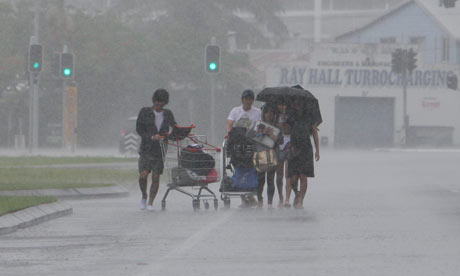Australia's recent extreme weather isn't so extreme anymore
Global warming theory says cyclones, flooding and droughts will become more commonplace – and it's already happening

Going by the first six weeks, 2011 has not been a good year to live in Queensland, Australia. In the first fortnight, we experienced heavy downpours, culminating in the south-east floods which killed 22. While we were still mopping up the damage, one of the biggest cyclones in our history hit the north Queensland coast. Cyclone Yasi had grown to a category five by the time it hit landfall. All this and we were barely into February.
You can understand if Queenslanders are feeling somewhat battered at the moment. But we're not the only part of Australia being afflicted by extreme weather.
Flooding has spread to the southern states. To the west, Perth hasn't got off lightly either, threatened with a cyclone last week and currently suffering from bushfires. Sydney just went through a record-breaking heat wave, with temperatures soaring into the mid- to high-30s for seven days running. The longest heat wave since records began in 1858.
When you scroll down the list of extreme weather events, we're ticking a lot of boxes. As an Australian, it can be somewhat disconcerting when climate bloggers from overseas hold up Australia as a harbinger of what's to come for their own countries. It's not fun being climate change's cautionary tale.
Okay, so we've had a bad start to the year. But if Queensland experiences two 1-in-a-100-year weather events within a few weeks, doesn't that mean we're off the hook for the next two centuries? If only. Unfortunately, the odds are changing.
An apt metaphor to understand how weather works is to consider the rolling of dice, which can be just as chaotic and unpredictable. What if you load the dice so one face is heavier? This increases the chances of rolling a certain number. Global warming loads the dice, and here's how.
As the climate gets warmer, more water evaporates and the air holds more moisture. Over the past 40 years, the amount of water vapour in the atmosphere has risen by 4%. Lately in Australia, we've been measuring everything by Sydney Harbours. Globally, the amount of extra water vapour in the air due to warming is equivalent to more than 900 Sydney Harbours. All that extra water vapour increases the chance of an extreme rainfall event.
It's not appropriate to say global warming causes a particular weather event. But it's equally false to say global warming has no effect on weather. Yes, we've had floods and heavy downpours in the past, well before modern global warming. But now the odds of heavy downpours and floods are increasing.
In fact, our physical understanding of climate tells us global warming will cause the water cycle to grow more intense. This means both more heavy downpours and more intense drought. As temperatures rise, the ground dries out faster, causing droughts to get worse. So we find ourselves swinging from one extreme to another, like an ever deepening rollercoaster ride.
Wait a minute, scoffs the sceptic. How can global warming cause droughts and floods? Aren't you just trying to blame everything on climate change? But increased drought and heavy downpours aren't just predictions from a climate model. They're happening in the real world.
In Australia, farmlands that were parched from years of drought were recently wiped out by floods. Over the past 50 years as the world has warmed, both drought severity and the number of heavy precipitations events have increased. The results are in from the most comprehensive, sophisticated climate model of all – nature.
Nature has also spoken on other extreme weather such as heat waves. While some regions are suffering record high temperatures, it's true that other places are experiencing unusually cold temperatures. But the overall picture is clear – we're experiencing twice as many record highs as record lows. This is what we expect with global warming and this is what we observe.
One hopes this rash of extreme weather events will be a wake-up call for an Australian government dragging its feet on climate action. However, the early signs are not encouraging. To pay for flood damage, Prime Minister Gillard cut funding to a number of programmes designed to reduce carbon emissions. These include schemes for cleaner cars and a number of boosts for the solar industry. As Greens senator Christine Milne expressed, cutting climate change programmes to fund disaster relief is like cutting off your nose to spite your face.
Another unique if somewhat bleak perspective on this course of action came from a Twitter user who described the government reaction as a new man-made reinforcing climate feedback. If we don't act strongly to solve climate change soon, we might end up spending all our energies on just surviving with it.







No comments:
Post a Comment